| June 1944 Popular Mechanics |
 [Table of Contents] [Table of Contents]
Wax nostalgic about and learn from the history of early
mechanics and electronics. See articles from
Popular Mechanics,
published continuously since 1902. All copyrights hereby acknowledged.
|
A relatively small number
of people are responsible for building the world's most massive projects.
Conceiving of, gathering support for, designing, building, and making
operational gigantic dams, seaports, airliners, ships, railroads, skyscrapers,
hospitals, highway systems, food processing plants, oil refineries, canals, is
the domain of a very few engineers, scientists, managers, tradesmen, bankers,
and manufacturing concerns. This article in the June 1944 issue of Popular
Mechanics magazine reports on the building of the Grand Coulee Dam in
Washington state. Take a look at the scale of the components being assembled,
and consider the manufacturing facilities and people that built those parts. How
does anyone take on such a monuments task? Imagine the satisfaction and pride in
knowing you participated in such a project. From the late 19th century through
the middle of the 20th century, Western minds and hands built the modern world's
foundation. At the same time, some cultures were (and still are) living in mud
huts and communicating with each other with tongue clicks and hand gestures.
Now, we're supposed to feel guilty for advancing civilization while allowing
others to degrade us and force us to "admit" that it was actually they who did
all the thinking and work. These are insane times.
Switchyards for the Nation's Power
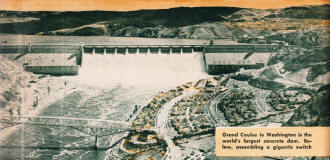
Grand Coulee in Washington is the world's largest concrete dam.
A heavy rainstorm in northern California is of more than local importance, for
it may set into operation a chain of events that has a final effect in Texas, half
a continent away. The flow of natural gas or fuel oil from a Texas petroleum field
may have to be increased solely because of a rainstorm on the Pacific coast.
This odd situation exists because of interconnections between electric power
systems. Hooking the systems together makes it possible to draw upon distant sources
of power in times of need. Interconnections allow the electrical industry to balance
its power sources so that the perpetual demand for electricity is constantly satisfied.
The full story of the tie-up between the California rain-storms and the Texas
oil field is complex but a simplified outline might go like this: in anticipation
of future needs, the public utility that serves the San Francisco area has been
conserving the water in its northern storage reservoirs, meanwhile buying power
from the Southern California Edison Company via a hydro-electric plant in the central
mountains. When a big storm assures a surplus of water in the north, the San Francisco
utility increases its own hydro-electric output and disconnects from its neighbor.
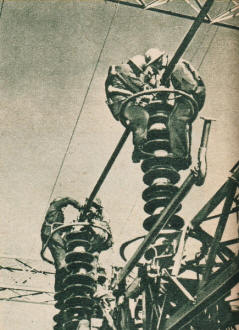
Assembling a gigantic switch.
This allows the southern company to route the unused power over its transmission
lines to Los Angeles and permits it in turn to reduce its demand on the generators
at Boulder Dam in Nevada. Boulder, accordingly, reduces the flow of water through
its turbines, which curtails the amount of water that flows downstream to another
powerhouse at Parker Dam.
The Parker powerhouse has a guaranteed minimum flow of water on which it can
depend but in these days of high demand its turbines need every drop they can get.
When Parker's generators slow down, the power companies in Arizona that are connected
to Parker must turn to stand-by steam plants to make up the difference. These steam
plants are the final link in the chain, for they burn oil piped from Texas.
This example of interconnection is not far-fetched. It has even happened that
power from Boulder Dam, flowing along transmission lines down into Mexico and west
to the coast, has provided the initial link in a chain that made it possible for
a power company in Idaho to meet an unusually heavy demand for electricity. Boulder
power was not, of course, transmitted all that distance. Power from the dam was
used simply to satisfy the needs of an adjacent area, allowing the area's normal
source of power to feed its electricity into the next adjacent area, and so on up
the line to Idaho.
Interconnection, too, makes it possible to ship fuel. oil, coal, or natural gas
by transmission lines instead of by rail. This is accomplished by substitution,
explains N. B. Hinson, executive engineer of the Southern California Edison Company
and chairman of the Pacific-Southwest Power Interchange Committee. It may be that
a certain small power system needs 10 carloads of fuel oil per day to keep its steam
plant operating, and this fuel oil may have to be hauled hundreds of miles by rail.
Often the best way is to convert the oil or other fuel into electricity at some
steam plant close to the fuel source, and deliver the energy by transmission line
where it is needed.
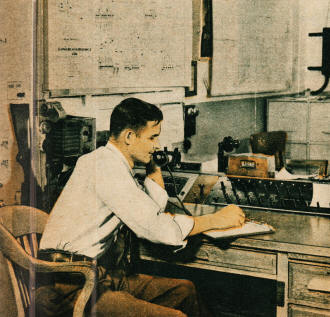
Electric sub-station operator maintaining contact with a field
lineman who reports over short-wave radio. Southern California Edison Co. photo
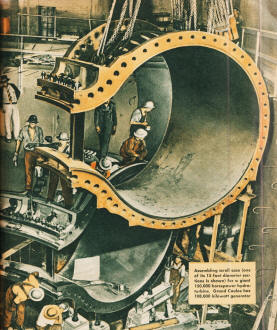
Assembling scroll case (one of its 15·foot diameter sections
is shown) for a giant 150,000 horsepower hydro-turbine. Grand Coulee has 108,000
kilowatt generator.
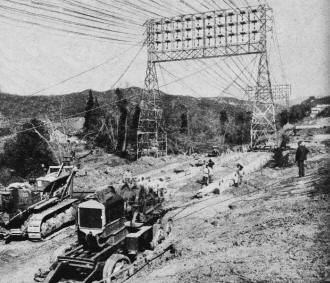
Moving bridge-type transmission tower without interrupting flow
of current through its 11 circuits.
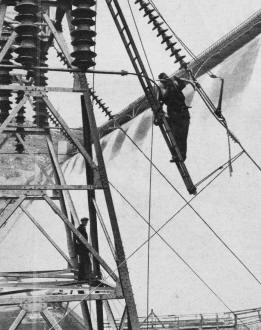
Electricians string cables that will transmit Grand Coulee power
northwest.
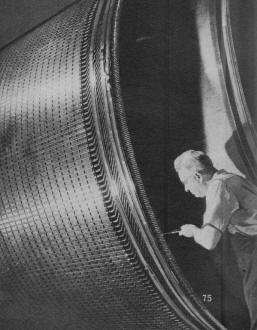
A 100-ton copper and steel rotor for a new 7,000 horsepower electric
motor. The rotor will be used to turn out steel plate for war.
Electricity is an indispensable servant of civilization and in spite of the many
tasks it performs today its greatest utilization still lies in the future. Handling
power in bigger amounts than ever before, the power industry is constantly overcoming
new problems, putting electricity to new uses. One new use, electro-metallurgy,
alone demands vast amounts of power.
Up in the Pacific Northwest, five aluminum refining plants that didn't exist
three years ago are now producing more aluminum than was produced in the whole country
five years ago. This is possible because of the electrical output of Bonneville
and Grand Coulee dams on the Columbia River. Power from Grand Coulee alone would
light three 60-watt bulbs in every home in the United States. Even so, installation
of the turbo-generators that will make Grand Coulee the world's greatest' powerhouse
has not yet been completed. That title is still held by the generators at Boulder
Dam.
When Boulder was built, no one dreamed that one industrial plant alone would
shortly consume one fourth of its tremendous output of electricity. Yet that is
the demand of Basic Magnesium, Inc., which uses more electricity than do half a
dozen of the most sparsely settled western states together. Inside the plant buildings,
many parts of the electrical system have been air conditioned so that the heavy
power loads can be carried safely in spite of high summer temperatures. Air conditioning
created its own problems, for the moisture in conditioned air combines with chlorine
that is used in the plant process and causes corrosion, even on the surfaces of
the huge silver and copper bus bars used as conductors. Exposed portions of the
electric system must be kept painted.
Not long after BMI went into operation, mysterious flash-overs started in an
outdoor 230,000-volt switchrack. Big bluish arcs flamed down over the insulators
to ground. Then the circuit breakers kicked open. The cause was a film of dust from
the magnesium operations settling on the insulators. The dust was inert as long
as the atmosphere remained dry but in high humidity it became a conductor, allowing
the current to short across the insulators. Now the insulators are washed regularly.
New problems are always coming up. The caddis fly, for instance, favored by fishermen
as a lure for trout, is a headache to hydro-electric engineers in some areas. The
little insect has been known to reduce the output of a power plant as much as 10
percent. The larvae of the fly, floating downstream, attach themselves to the walls
of intake tunnels that lead to the power turbines. They spin webs that catch particles
of dirt, reducing the tunnel's diameter and cutting down the amount of water that
reaches the turbines. Intake tunnels must be cleaned of the growths each spring.
To reduce energy losses, engineers put a motor-generator set that is used for
changing current from one frequency to another inside an airtight steel shell, then
fill this shell with pure hydrogen. Hydrogen is a better conductor of heat than
is air, so the machine operates at a cooler, more efficient temperature. Hydrogen
is lighter than air, also, and the energy used by the machine's rotating parts in
overcoming air resistance is reduced. As much as 500 kilowatts of power that otherwise
would be lost is saved when a big frequency changer is operated in a hydrogen atmosphere.
Early in the war it was feared electricity would have to be rationed, so great
were the industrial demands. By adding to its generating capacity, by interconnection,
and by increasing its efficiency, the American power industry has kept ahead of
the greatest demand it ever faced.
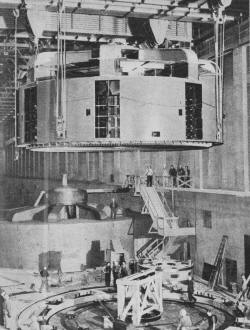
Lowering 220-ton stator of 108,000 kilowatt generator into Grand
Coulee's powerhouse.
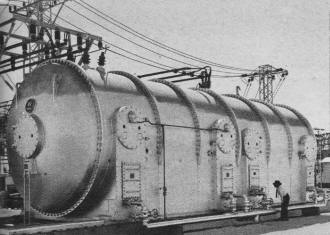
Fifty-cycle current goes in one end of this frequency changer
and 60 cycle current comes out the other end. Southern California Edison Co, photo.
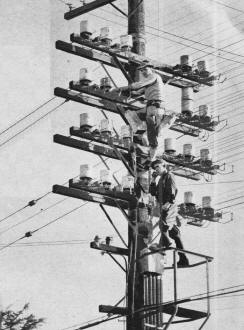
Linemen checking capacitors and protective equipment by which
the high voltage transmission lines can carry telephone conversations.
Posted December 14, 2023
|